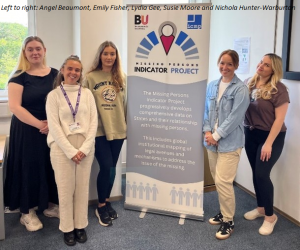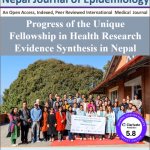The Missing Persons Indicator Project, initiated several years ago by Professor Melanie Klinkner and Andreas Kleiser from the ICMP, has recently been enhanced by a visit to the ICMP, aimed at optimising knowledge exchange. Its goal is to showcase each state’s relationship with missing persons through comprehensive data analysis. This initiative began as a collaborative effort, with data gathering undertaken by undergraduate students at Bournemouth University, engaging students in real-world research and ensuring the project’s sustainability by welcoming new students each September.
Since its inception, the project has been fortunate to work with many enthusiastic students who have completed the first round of Structural Indicator 1. This indicator demonstrates the commitment of states to international legal instruments. The table below outlines the current indicators involved in our data collection process:
| Context Indicator | A qualitative assessment as to whether the state has experienced extraordinary events that may be correlated to a rise in missing persons cases. |
| Structural Indicator 1 | The commitment shown by states to international legal instruments is an indicator of their duties and obligation in relation to missing persons. |
| Structural Indicator 2 | Domestic legislation by states as an indicator of their duties and obligation in relation to missing persons. |
| Structural Indicator 3 | Institutional framework(s) established by states as an indicator of their duties, obligation, and enactment of legislation in relation to missing persons. |
Thanks to HEIF funding, the Missing Persons Indicator Project recently had the opportunity to employ four student volunteers over the past two weeks. Their task was to accelerate the data collation for these indicators. By working through each indicator on a state-by-state basis, they developed a comprehensive understanding of each state’s unique situation. This method also allowed them to recognise and utilise specific details that might recur across the different indicators.
Every day, a designated “data-checker” reviewed previously inputted data to identify and correct any anomalies. This rigorous review process ensures the data’s accuracy, ethical integrity, and suitability for international dissemination.
Throughout this process, the students have been deeply engaged, asking insightful questions that challenged our perspectives and prompted us to consider aspects we might have overlooked. The atmosphere has been a hub of activity and intellectual growth.

We are extremely grateful for the hard work and dedication of our student researchers. Their contributions have demonstrated that a student ‘data-lab’ is an excellent model for conducting research and achieving meaningful results.
As this term draws to a close, we are keen to alert teaching staff to the potential for their students to join the Missing Person Indicator project in September as we recruit a new cohort for the new academic year. To learn more about the project please visit our website!
 2023-24 Missing Persons Indicator Cohort begins work
2023-24 Missing Persons Indicator Cohort begins work Bournemouth Research on mass grave protection and investigation presented to Iraqi authorities
Bournemouth Research on mass grave protection and investigation presented to Iraqi authorities










 Fourth INRC Symposium: From Clinical Applications to Neuro-Inspired Computation
Fourth INRC Symposium: From Clinical Applications to Neuro-Inspired Computation ESRC Festival of Social Science 2025 – Reflecting back and looking ahead to 2026
ESRC Festival of Social Science 2025 – Reflecting back and looking ahead to 2026 3C Event: Research Culture, Community & Cookies – Tuesday 13 January 10-11am
3C Event: Research Culture, Community & Cookies – Tuesday 13 January 10-11am Dr. Chloe Casey on Sky News
Dr. Chloe Casey on Sky News Final Bournemouth University publication of 2025
Final Bournemouth University publication of 2025 ECR Funding Open Call: Research Culture & Community Grant – Application Deadline Friday 12 December
ECR Funding Open Call: Research Culture & Community Grant – Application Deadline Friday 12 December MSCA Postdoctoral Fellowships 2025 Call
MSCA Postdoctoral Fellowships 2025 Call ERC Advanced Grant 2025 Webinar
ERC Advanced Grant 2025 Webinar Horizon Europe Work Programme 2025 Published
Horizon Europe Work Programme 2025 Published Update on UKRO services
Update on UKRO services European research project exploring use of ‘virtual twins’ to better manage metabolic associated fatty liver disease
European research project exploring use of ‘virtual twins’ to better manage metabolic associated fatty liver disease